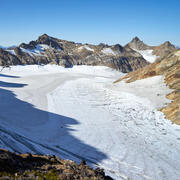Glaciers
Glaciers store water as ice, transport it from where it fell as precipitation, and release it to streams and rivers years to millennia later. The Climate R&D Program focuses on documenting changes in glacier mass balance (how much water they contain), understanding magnitudes and drivers of change, and evaluating the impacts on freshwater availability, sea-level rise, and downstream communitie









